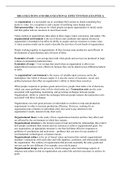ORGANIZATIONS AND ORGANIZATIONAL EFFECTIVENESS (CHAPTER 1)
An organization is a tool people use to coordinate their actions to obtain something they
desire or value. It is a response to and a means of satisfying some human need.
Entrepreneurship = the process by which people recognize opportunities to satisfy needs
and then gather and use resources to meet those needs.
Value creation at organizations takes place at three stages: input, conversion, and output. The
organizational environment is the set of forces and conditions that operate beyond an
organization’s boundaries but affect its ability to acquire and use resources to create value.
A value-creation model can be used to describe the activities of most kinds of organizations.
People working together in organizations they become more productive and efficient
development of specialization and a division of labor.
Economies of scale = cost savings that result when goods and services are produced in large
volume on automated production lines.
Economies of scope = Cost savings that result when an organization is able to use
underutilized resources more effectively because they can be shared across different products
or tasks.
An organization’s environment is the source of valuable input resources and is the
marketplace into which it releases output. It is also the source of economic, social, and
political pressures that affect an organization’s ability to obtain these resources.
When people cooperate to produce goods and services, people must make a lot of decisions,
which can cause problems (who will do which tasks etc). Transaction costs are the costs
associated with negotiating, monitoring, and governing exchanges between people.
Organizations’ ability to control the exchanges between people reduces the transaction costs
associated with these exchanges.
Organizations can exert great pressure on individuals to conform to task and production
requirements in order to increase production efficiency. However, working for an
organization puts a burden on individuals (they also need to pay attention to the
organization’s needs, instead of only their own).
Organizational theory is the study of how organizations function and how they affect and
are affected by the environment in which they operate.
Organizational structure is the formal system of task and authority relationships that control
how people coordinate their actions and use resources to achieve organizational goals. For
any organization, an appropriate structure is one that facilitates effective responses to
problems of coordination and motivation – problems that can arise for any number of
environmental, technological, or human reasons.
Organizational culture is the set of shared values and norms that controls organizational
members’ interactions with each other and with suppliers, customers, and other people outside
the organization. The cultures of organizations that provide essentially the same goods and
services can be very different. (For example, coca cola & pepsi).
Organizational design is the process by which managers select and manage aspects of
structure and culture so that an organization can control the activities necessary to achieve its
goals.
, Organizational change is the process by which organizations move from their present state
to some desired future state to increase their effectiveness. The goal of organizational change
is to find new or improved ways of using resources and capabilities to increase an
organization’s ability to create value, and hence its performance.
Organizational design has become one of management’s top priorities, due to the increasing
use of advanced IT.
A contingency is an event that might occur and must be planned for, such as a changing
environment pressure or the emergence of a new competitor.
Competitive advantage is the ability of one company to outperform another because its
managers are able to create more value from the resources at their disposal. Competitive
advantage springs from core competences, managers’ skills and abilities in value0creation
activities.
Strategy is the specific pattern of decisions and actions that managers take to use core
competences to achieve a competitive advantage and outperform competitors.
An organization needs to design a structure and control system to make optimal use of the
talents of a diverse workforce and to develop an organizational culture that encourages
employees to work together.
Researches analyzing what CEOs and managers do have pointed to control, innovation, and
efficiency as the three most important processes managers use to asses and measure how
effective they, and their organizations are at creating value.
In this context, control means having control over the external environment and having the
ability to attract resources and customers. Innovation means developing an organization’s
skills and capabilities so the organization can discover new products and processes.
External resource approach is a method managers use to evaluate how effectively an
organization manages and controls its external environment.
Internal systems approach is a method that allows managers to evaluate how effectively an
organization functions and resources operate.
The technical approach allows managers to evaluate how efficiently an organization can
convert some fixed amount of organizational skills and resources into finished goods and
services. It is measured in terms of productivity and efficiency.
Managers create goals that they use to asses how well the organization is performing:
- official goals are guiding principles that the organization formally states in its annual report
and in other public documents. Usually, these lay out the mission of the organization: goals
that explain why the organization exists and what it should be doing.
- operative goals are specific long and short-term goals that guide managers and employees
as they perform the work of the organization.





